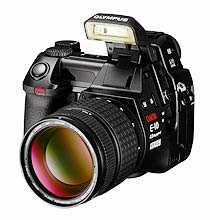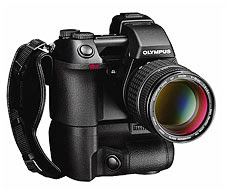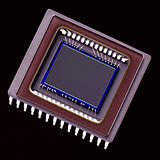Olympus Camedia E-10 Digital SLR Camera


Fuelled by the introduction of models offering 3-megapixel-plus imaging and other advanced features, the digital camera market continues to experience explosive growth. A number of digital SLRs have also been introduced, but with respect to price and product availability, virtually all of these have been aimed at the photojournalist and professional markets.
Olympus Optical Co., Ltd., however, has emphasized the development of consumer-oriented models since it first entered the digital camera market. In the fall of 1997, it introduced its first digital SLR, the
CAMEDIA C-1400L. This was followed in the fall of 1999 by the
CAMEDIA C-2500L digital SLR. Now, with the launch of the CAMEDIA E-10, it has a flagship digital SLR that breaks significant new ground in terms of image quality and functionality. Despite being brought to market at moderate price, the CAMEDIA E-10 offers truly outstanding photo-imaging quality, functionality, reliability and features. As such, it brings ultra-high digital SLR performance to a much wider market segment than ever before.
The CAMEDIA E-10 is the first camera in its class to feature a 4-megapixel*, 2/3-inch, primary-color CCD. In addition, by freeing its lens designers from the constraints of conventional 35mm-format interchangeable lens design, Olympus was able to develop a new 4x optical zoom lens that is specifically designed to match the size and performance characteristics of CAMEDIA E-10's CCD. In addition to offering 4x zoom, the lens has the exceptional light-gathering power of an F2-F2.4 aperture range. One ED (Extra-low Dispersion) and two aspherical lens elements are used to assure excellent edge-to-edge resolving power, and all lens elements are multicoated to limit internal reflection and assure crisp, clear imaging. Other advanced features include TruePic image processing, which assures that 4-megapixel image data is accurately represented at all output resolutions, and a new white-balance function for superior image quality in a wide range of shooting situations.
A shutter-release lag-time of only about 60 milliseconds was achieved by using a proprietary new auto exposure algorithm and a dual active/passive autofocus system for high-speed focusing. As a result, responsiveness and shooting ease are truly outstanding.
A variety of extension lenses, external flash unit "FL-40 electronic flash" and a remote cable and a wireless remote control are also available, making the CAMEDIA E-10 a digital SLR camera that is fully able to meet the needs of commercial and professional users.
* Number of effective pixels is 3,900,000.
Main Features
1. Professional-Oriented, Ultra-High Image Quality
4-Megapixel 2/3-Inch Primary-Color CCD At 4,000,000 pixels (3,900,000 effective), the CAMEDIA E-10's CCD imaging device offers the highest resolution currently available in a consumer-use digital camera. In addition, the CCD's large, 2/3-inch imaging area ensures excellent tonal sensitivity, while primary-color filtering is used to ensure vivid color reproduction.
Large-Aperture, High-Performance 4x Optical Zoom Lens
The lens is an F2-F2.4, equivalent to 35-140mm (in a 35mm format) bright, large-aperture zoom lens that is specifically designed to maximize the imaging potential of the camera's CCD. An ED glass lens element minimizes color aberration, and two aspherical lens elements correct distortion. In addition, all lens elements are multi-coated to ensure exceptionally crisp imaging.
Proprietary TruePic Image Processing
A refined version of the TruePic processing algorithm introduced on the
CAMEDIA C-2500L ensures superior image quality at any resolution. As a result, even small images can take full advantage of the CCD's 4-megapixel imaging power.
Digital ESP Metering for Correct Exposures
New auto-exposure algorithms assure balanced exposures. In addition, the camera offers a choice of center-weighted average metering or spot metering.
New White-Balance System for Natural Skin Tones
A newly developed white-balance system provides more accurate assessment of white values than previous systems. Color fidelity is enhanced, and skin tones are more natural and lifelike.
2. Professional-Oriented Speed and Responsiveness
Dual Autofocus System for Quick Focusing
Fast, accurate focusing is provided by an advanced dual autofocus system that combines single-beam, twin-sensor active AF technology with passive AF technology. After initial measurement is made with the single-beam, twin sensor system, fine tuning is carried out with the passive system. In extreme low-light conditions, the twin-sensor active system alone can be used, thus greatly extending the range of situations in which digital photographs can be taken.
Shutter-Release Lag Time of Only 60ms (approx.)
A shutter-release lag-time is only about 60 milliseconds when LCD monitor and internal flash are turned off. Shutter release is smooth and responsive for stress-free shooting.
4-Shot Continuous Shooting at Speeds Up To 3 fps
A 32MB buffer memory and dedicated ASIC (Application-Specific Integrated Circuit) provide high-speed image processing for megapixel images. As a result, continuous shooting capability is offered in all image quality modes, up to a maximum of four frames at three frames-per-second.
High-Capacity Lithium-Polymer Battery Support
An optional Power Battery Holder Kit and high-capacity lithium-polymer batteries can be used to handle long photo sessions and high-volume shooting.
4 ISO Sensitivity Settings
ISO sensitivity settings include Auto, 80, 160 and 320, allowing photographers to shoot indoors without flash and avoid camera-shake blurring on telephoto shots.
Rugged, Die-Cast Aluminium Body
The rugged, die-cast aluminium body is built to withstand the rigors of adverse shooting conditions.
3. Professional-Oriented Features and Functions
TTL Viewfinder with 95% Field of View
The TTL viewfinder eliminates framing errors caused by parallax displacement and provides a field of view that covers 95% of the total image area. Indicators within the viewfinder allow essential settings to be confirmed without taking the eye away from the eyepiece. In addition, the eyepiece features -3 - +1 dioptric correction and a special shutter that prevents light from entering the eyepiece when a picture is taken.
Multi-Angle 1.8-Inch TFT Color LCD Monitor
A quick-response 1.8-inch color LCD monitor allows captured images to be instantly viewed. It can also be used as a viewfinder, with multi-angle display that provides a clear view for waist-level or high-angle shooting.

Fast, Easy Mode Selection
Individual buttons are provided for all frequently used shooting modes, and are positioned for easy access when the camera is held in the normal shooting grip.
Advanced Flash Control System
A powerful GN13 (ISO 80) pop-up flash is built-in. Featuring advanced 'scene detection' technology, it automatically adjusts flash illumination to suit the subject's position, assuring beautiful auto flash exposures. +/- 2-step flash power compensation can also be used to achieve an ideal balance between natural light and flash illumination. In addition to forced (fill-in), slow-synchro and red-eye reduction modes, the flash also offers rear-curtain synchronization. An optional FL-40 external flash unit can also be connected via hot shoe or cable for full-auto, dual-flash shooting, and an external PC synchro socket allows other external flash units to be connected for multi-flash shooting.

Wide Selection of Exposure Modes
Four exposure modes are offered: Program AE, Aperture-Priority AE, Shutter-Speed- Priority AE, and Manual. Aperture and shutter speed can be quickly set via an electronic dial, and an AE Lock button is positioned so that it can easily be pressed with the right thumb. The wide range of exposure settings allows photographers to take full advantage of the exceptionally bright lens, and to easily capture long bulb exposures at night.
Versatile Exposure Control
+/- 3EV exposure compensation can be set in 1/3EV-step increments. With Auto bracketing function, the camera can shoot sequent shots of 3 frames in 1/3, 2/3 and 1EV steps.
Three White Balance Modes
In addition to Auto White Balance, one-touch White Balance can be stored in memory to assure correct color balance when shooting under various types of light source. Photographers can also achieve the precise color balance they want by choosing from seven manual White Balance settings (3000K, 3700K, 4000K, 4500K, 5500K, 6500K and 7500K).
Three Image Sharpness Settings
Hard, Normal and Soft image sharpness settings allow photographers to choose the level of image sharpness that best suits their purpose (i.e., printing, image manipulation, etc.).
Three Contrast Settings
High, Normal and Low contrast settings can be selected according to the photographer's preference.
Manual Focus
A focusing ring is provided to allow easy manual focusing when shooting subjects that are difficult for the autofocus system to handle.
Macro Mode
Macro photos can be taken from as close as 20cm at any zoom setting. At maximum magnification, an area of 76mm x 57mm fills the frame.
SmartMedia and CompactFlash Memory Card Support
Slots are provided for both 3V (3.3V) SmartMedia and CompactFlash memory cards of up to 128MB. Both types can be used simultaneously to extend memory capacity for worry-free, high-resolution shooting. The slots are linked, and a dedicated button is provided for slot switching. In addition, images can be copied from one card to the other at any time.
Raw Image Data File Storage
Unprocessed, raw data can be saved to allow subsequent high-level processing for printing or commercial purposes. A dedicated Adobe(r) Photoshop(r) plug-in will be also provided.
USB Support
A USB interface is provided to facilitate downloading of large image files. In addition, USB Storage Class support allows image files to be accessed using standard personal computer directory protocols.
4. System-Oriented Options and Accessories
4 Types of High-Performance Extension Lenses
3x focal length telephoto (420mm equivalent*; F2.8), 1.45x telephoto (200mm equivalent*; F2.4), 0.8x focal length wide-angle (28mm equivalent*; F2.0) and macro (49 x 37mm full-frame image area) extension lenses are available to extend shooting flexibility.
* Focal length is in a 35mm format.
Product Name
Tele Extension Lens Pro TCON-300S
Tele Extension Lens Pro TCON-14B
Wide Extension Lens Pro WCON-08B
Macro Extension Lens Pro MCON-35
Versatile Power Supply Options
An optional B-30LPS Power Battery Holder Kit with high-capacity lithium-polymer batteries is available for long photo sessions and high-volume shooting.

FL-40 Electronic Flash for Creative Flash Photography
A powerful GN40 dedicated external flash unit with a rotating head for creative bounce-flash photography.
Remote Cable Release
The RM-CB1 Remote Cable allows remote shutter operation.The multi-function RM-1 is an optional remote control unit that allows functions such as shooting and image playback to be controlled from a distance. Can also be used to control the camera when it is being used as a playback device for slideshows and business presentations displayed on a video monitor.
5. Other Features and Functions
Shooting data such as aperture and shutter speed can be displayed on the monitor when viewing images.
Image histograms can be displayed on the monitor.
Time-lapse shooting intervals can be set from one minute to 24 hours.
Control panel is equipped with backlight.
Audible shutter release can be set to High, Low or Mute.
Olympus Optical Co., Ltd. was changed to OLYMPUS CORPORATION as of October 1, 2003. The company names and product names are the trademarks or registered trademarks of each company. Pictures (c) Olympus Corporation - Olympus Press Release - 22.08.2000 Update: 20.02.2001.






